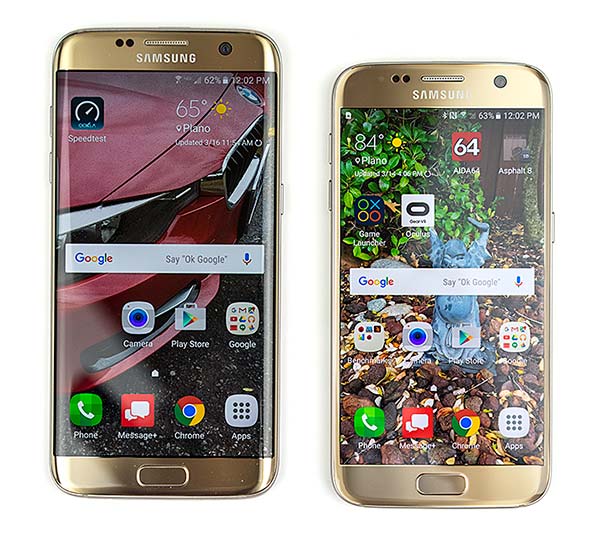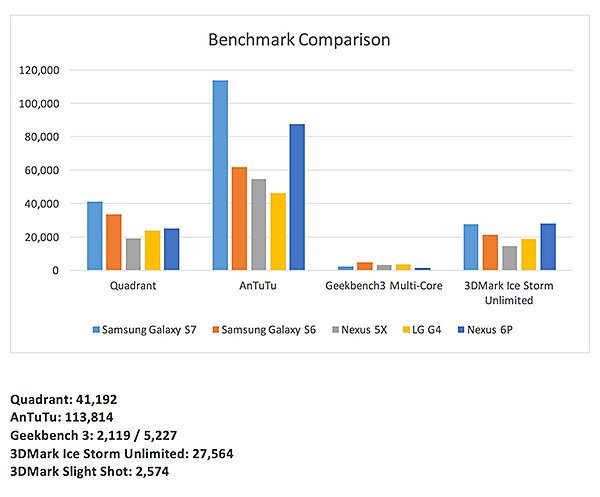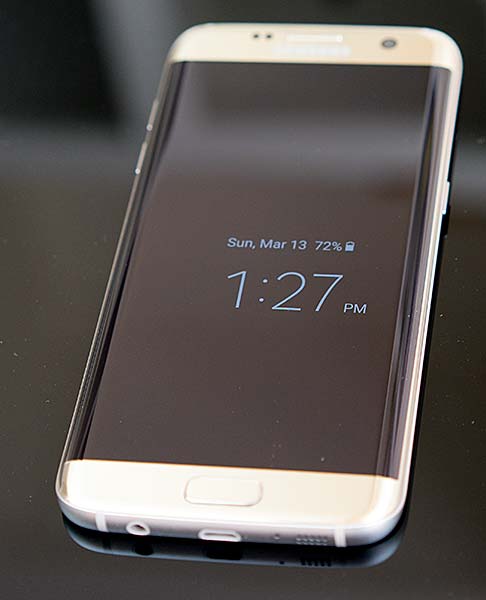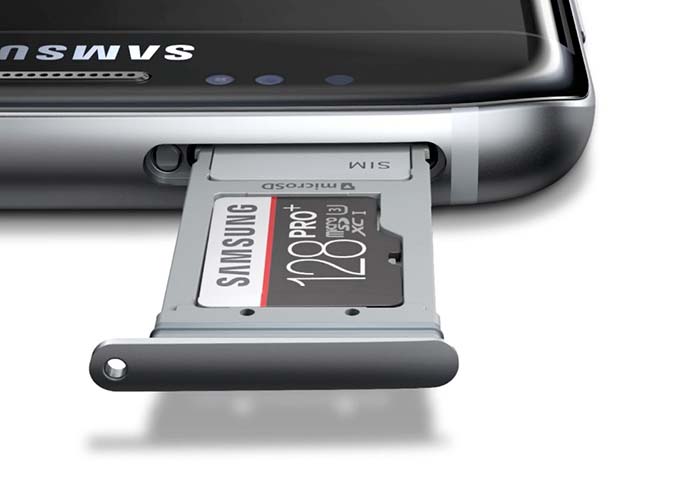Horsepower and Software
The US models run on the quad core 2.1 GHz Qualcomm Snapdragon 820 CPU, the top of the line processor that shows significant benchmark improvements over the outgoing Snapdragon 810 that wasn't what we'd all hoped--it ran hot and wasn't much faster than what it replaced. Overseas, Samsung uses their own Exynos 8890 CPU, which should show similarly strong performance. The phone benchmarks quite a bit faster than the Galaxy S6 and other flagship Android phones. The LG G5 will also have this CPU, but anything older will benchmark slower, even our beloved Nexus 6P (though the Nexus 6P comes close in some graphics tests). Do you need this much speed? Probably not, but it does offer the reassurance of future-proofing and it has the necessary performance to drive the Samsung VR virtual reality headset (often bundled at launch) well.

The phones have 4 gigs of RAM, and that's currently the most you'll find in Android smartphones. They have 32 gigs of storage and a microSD card slot compatible with cards up to 200 gigs (we tested them with a SanDisk 200 gig card and it works just fine). You can save photos and videos you've taken to the card, and transfer apps to the card. Not all apps support this feature, however. The phone let us move the large game Asphalt 8 Airborne to a card, but not the 5 (very large) bundled Gear VR games to a card.
The Samsung Galaxy S7 and S7 edge (both run on the exact same CPU, Adreno 530 graphics, 4 gigs of RAM and 32 gigs of storage) feel very responsive and we didn't experience any lag whatsoever. Samsung's TouchWiz improvements and the power of the latest CPU work well here. Of course there's still Samsung bloat or value added software, depending on your opinion of Samsung's offerings. Multi-window multitasking is handy, as is Smart Stay (keeps the phone's screen on if you're looking at it). The redundant music and video apps are no longer pre-installed (Google's standard Android apps are still here), but you can download Samsung's apps if you miss them. Carrier bloatware abounds on US models, and the titles will vary by carrier.
The phone runs Android 6 Marshmallow with Samsung's TouchWiz UI. That's currently the latest version of Android available (Google is only making the next version, Android N available to developers now). Samsung is typically slow to release OS updates for their smartphones, likely due to their heavy UI overlay that necessitates more customization and testing. So don't expect to be the first on your block to run Android N when Google releases the final version (you'll likely be closer to last). TouchWiz is as ever toned down and we actually don't hate it anymore. Sure, we're used to it (resigned to it?), but several of the customizations like multi-window multitasking are very useful, and won't be available to other brands until Android N ships. Samsung uses squircle icons that are rounded squares rather than stock icons, and they modify the settings menu--we can live with that or install a 3rd party launcher when it gets old. Samsung offers a variety of themes for those who want a different or even slightly more stock Android theme.
Benchmarks

Cameras
The 12MP rear camera is a downgrade in resolution but it takes simply stunning photos and video by camera phone standards. The iPhone 6s and 6s Plus also have 12MP rear cameras, and I've yet to hear anyone complain about them. The new Sony dual pixel sensor allows for even faster autofocus (not that anyone complained that the GS6 was slow to focus) and it has larger sensor sites (tied to the drop in resolution to reduce pixel density and make room for larger sensor pixels). That means very good low light shots with accurate, colorful and low noise photos and videos. Watch our video review to see some low light and outdoor examples--they're superb for a camera phone and even beat some dedicated point and shoot cameras. This is one of the best camera phones on the market, and possibly the best. It offers a bit better low light performance than the iPhone (more color captured), has enough megapixels to provide sharp, detailed images that compete well against 16MP camera phones (including Samsung's own Galaxy S6 and the LG G4). Images are natural and have a 3 dimensional look that's still not common in phone cameras.

The camera can shoot photos in 16:9, 4:3 and 1:1 aspect ratios, and it has auto HDR, panorama and a variety of settings and effects, including manual control. Honestly the auto mode does a superb job, even in challenging situations. The software looks very similar to other recent Samsung Galaxy phones like the Note 5 and GS6, and that's fine with us since Samsung does an excellent job of packing features in without making the UI cluttered or confusing.
The camera on both models has OIS (optical image stabilization), a fast f/1.7 lens and a two tone LED flash. They can shoot 4K video at 30 fps, 1080p and slow motion at 240 fps. Video quality is excellent, particularly in 4K mode and stabilization effectively reduces the effects of hand shake. The front 5MP camera with f/2.4 lens is good, in fact quite good, though it's not stellar. Exposure and noise were sometimes disappointing compared to the much lower resolution iPhone 6s front camera and the 8MP Huawei Nexus 6P's front camera beats them both.
Battery Life
The Galaxy S7 has a 3,000 mAh battery and the Galaxy S7 edge has a 3,600 mAh battery (both are sealed inside). They support fast charging, Qi wireless charging and fast wireless charging with Samsung's Fast Charge Wireless Charging Pad ($69.99). A fast charger is included in the box. Last year's GS6 didn't exactly universally impress folks with battery life. Heavy users sometimes found it didn't last a full day on a charge. The Galaxy S7, and even more so the bigger battery Galaxy S7 edge, last longer on a charge the the outgoing models, though they're still not marathon runners. The S7 edge has 600 mAh more battery capacity to work with, though that's slightly offset by the bigger display it drives. Even so, we found it lasted for 30 to 45 minutes longer (actual screen on time) compared to the S7. Both outlasted our Galaxy S6 and s6 edge in our comparison rundown tests. Typically the battery on each lasted from 8am to 10pm with moderate use (a few short phone calls, email, web, streaming a few YouTube videos, playing music with the screen off). The Galaxy S7 was down to 8% at 10pm, while the S7 edge had 15% charge remaining. Happily, the phones charge very quickly with the included fast charger--30 minutes topped the battery up by 40%.

Conclusion
The Galaxy S6 and edge phones were a groundbreaking redesign that otherwise fell short of greatness. Though the Galaxy S7 and S7 edge are evolutionary rather than revolutionary phones, Samsung's hit a home run by addressing just the right things we found lacking in the Galaxy S6 line. Now we get to have our beautiful Galaxies with that flagship look and feel, and we get removable storage, a more comfortable design, water resistance and a more refined evolution of TouchWiz. The camera proves that less can be more, and I'd pick the new 12MP S7 camera over the 16MP S6 camera. That said, if you already own a Galaxy S6 family phone, you've still got a great looking phone with one of the better cameras on the market and plenty of horsepower inside. The Galaxy S7 phones are for those who almost jumped on the GS6, but put on the brakes because of the missing SD card slot or lack of water resistance. And for those who liked the S6 edge+ but found it too big to handle and the standard S6 uncompellingly small-screened, the S7 edge is that Goldilocks phone.
The phones are expensive, but you do get best in class displays, designs, materials, processors, cameras, an excellent fingerprint scanner, removable storage and a chance at the Samsung Gear VR experience if that tickles your fancy. Price: ~ $700 for Galaxy S7 and $800 for Galaxy S7 edge (full retail)
Website: www.samsung.com
Related Reviews:
Samsung Galaxy Note 7 Review (discontinued)
Google Pixel & Pixel XL Review
HTC 10 Review
Moto Z and Moto Z Force Review
LG G5 Review
iPhone 7 & iPhone 7 Plus Review
Nexus 6P Review
Nexus 5X Review
Microsoft Lumia 950 Review
Samsung Gear Fit 2 Review |

